Learning Styles In The Classroom
Have you discussed the different types of learners in the classroom with your students?
How I figured out my Learning Style
How many hours have you wasted reading and re-reading a text only to find that none of it “stuck”? Looking back on your education, do you recall a specific lesson that just seemed to click? Was there a point in time where being a student seemed to come more natural to you?
Audible Learning
This all happened to me! Up through middle school, I struggled to get B’s and C’s. No matter how much I read the material, I just never seemed to recall it for tests. At that point, I just figured I was a below average student, and I’d have to live with that.
It wasn’t until mid-tenth grade when I had my “aha moment.” I made myself some history note cards for a test as I had done numerous times before.
This time, however, I read the note cards aloud to myself and verbally answered them. Then I turned them over to look and see if I was correct. I think I was just bored with learning and being goofy to keep things interesting. 😉 Little did I know that this goofiness would change things. This verbal/audible tactic made an immense difference in how I retained the information!
That history test was one of the easiest tests I’d ever taken. I was able to retain the information and recall it easily! I continued to study this way and wouldn’t you know, I got straight A’s in school for the next 4 years of high school and college!
This is how I learned that I was more of an audible learner than a visual one. Add a little bit of audible hands-on learning, and that’s when I really shine!
So it got me thinking about different types of learners in the classroom. Or as i'm about to explain, in my home.
Visual Learning
On a contrary note, my husband is just the opposite. We were college sweethearts and would study together. He would read through his notes, hand them to me and ask me to quiz him. If he couldn’t initially recall the information, he would say something like “I know that it’s four lines down and the definition is short.”
He was visually seeing the study guide in his head. He could read it and remember it. I did not know that this would be something that would affect our relationship in the future. You know how a wife says, “You never listen to me,” when a husband neglects to do something she had asked him to do? That was a prevalent statement in our relationship.
I’d ask him to pick up certain things at the store, only for him to come home empty-handed. At one point when we were heatedly discussing this “infraction,” he stated that if I ever want him to remember something, I have to put it in writing.
If he sees it in a text message, he will remember it. If he hears it in a phone call, it’s in one ear and out the other! This lead to the realization that my husband is a visual learner! He more easily recalls things when he reads them.
Learning Strategies
Are there lessons that you learned as a child that you can still recall today? I am this way with the preamble to the constitution of the United States.
My sister taught me a little melody that turned the preamble into a song with rhythm. Singing that song to myself and out loud made it easy to commit to memory. Thirty years later, I can still recall every single word, thanks to my sister teaching me that song.
I wish I would have known then that it was the audible learner in me that was recalling this information. I’d have done significantly better in grade-school had I understood that it was the audible part of it that assisted in my ability to retain the information.
When you know about different types of learners in the classroom, you can create some brilliant strategies to work into your lessons.
Why is it essential for students to figure out their learning style early in their education?
While a student is still in school, knowing how they learn is of great benefit to them. If you realized that you need to hear the information audibly in order to learn it, you would no longer waste your time reading and re-reading the text.
You would figure out that either you need to record the teacher during lectures or you would need to record your own notes verbally and re-listen to your recordings. You know you need to hear it to learn it; therefore, you adjust your study habits accordingly. To have each student learn about themselves and how they process information not only helps them in the classroom but in other aspects of their lives as well.
For example, when a kinesthetic learner is training for a new job, they will know that just reading the instructions will not be enough. They will see that they need to have hands on the project and do it themselves to learn it best. Knowing how they learn and adapting their study habits would make learning easier and more pleasant.
How knowing your learning style helps in the classroom and beyond
Take a visual learner who has gone into a speciality school after high school such as personal training. They will understand that they need to read and re-read the information to fully understand the content.
Visual learners will not be able to listen to a lecturer talk about the different muscles, nerves, and body-parts with a clear understanding. They will need to be looking at a picture, graph, or chart to grasp the information fully.
For an audible learner, it is a great benefit to know that they retain information better when it is stated and repeated out loud. Even if it is an effortless thing to remember as setting the alarm when their shift is over.
A person who knows they are an audible learner, and recognizes the importance of remembering this task will know to repeat this to themselves multiple times in order to remember it. That way, they don’t get fired after forgetting to do such a small but essential task.
A kinesthetic learner may be able to avoid wasted hours of reading and listening to a mentor tell them how to do something. They can nicely state that they know they are a kinesthetic learner. So it's best if they could be hands on while the mentor was teaching how to do the job.
This will help them learn faster and not waste anyone’s time or effort.
How this information helps you as a person
As an adult, there may also be a need for you to teach something to a group of people.
Understanding that there are different learning styles allows you to realize that while one individual may learn what you are trying to teach by just reading the instruction manual, another person may need to listen to you explain it.
A third person may need to be walked through how to do it themselves while you guide them step by step in the process. Understanding this allows you to be patient with those you are trying to teach. It enables you to realize that a different method of delivery may be required in order to educate specific individuals most effectively.
Every student is different! At the beginning of the year, it is helpful for a teacher to understand different types of learners in the classroom.
This will allow you to differentiate instruction and create an environment for all types of learners. Individual learning styles influence the way a student understands information and solves problems.
In order for you to help your students find their individual learning styles, you could try this activity called the Learning Style Student Inventory.
This will encourage your students to analyze their best learning potentials and allow you as a teacher to guide your lesson plans to reach every student more effectively.
Evaluating Learning Styles in the classroom early on is Ideal!
Students who know how they learn earlier in life and adjust their actions accordingly will thrive!
I wish I had known before the age of fifteen that I do better when I hear and say things. I would have adjusted the way I studied and would not have struggled so much in classes.
If my husband had learned early on that he only remembers things when he sees them, he would have learned to carry around a notebook with him (like he does now) to write down anything he needs to remember. Even if it is just picking up a gallon of milk on the way home!
Knowing different types of learners in the classroom and how they learn will make your students better learners in school and in life!
If you're looking for different strategies for your students, check out my blog about using escape rooms for learning! I have a specific test prep escape room suitable for all subjects.

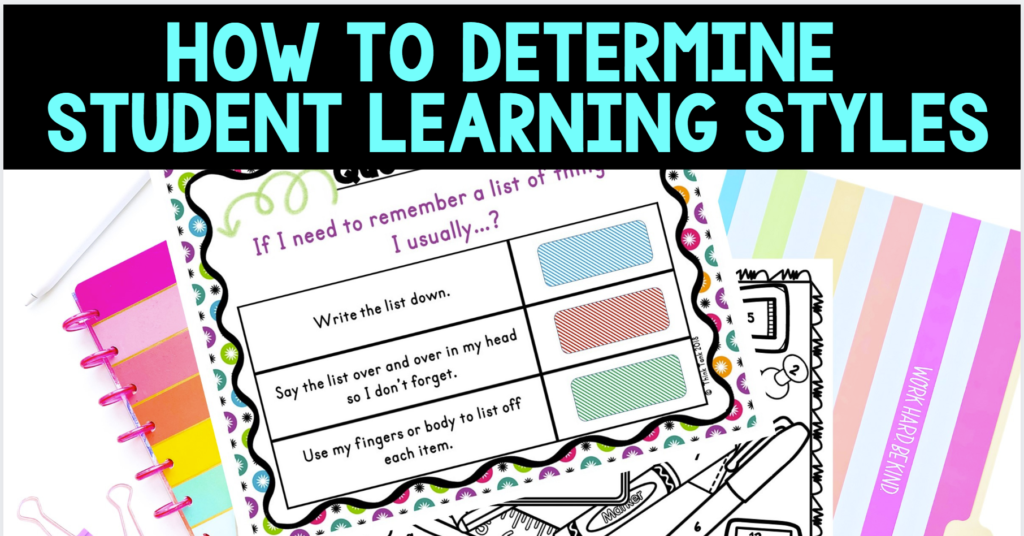
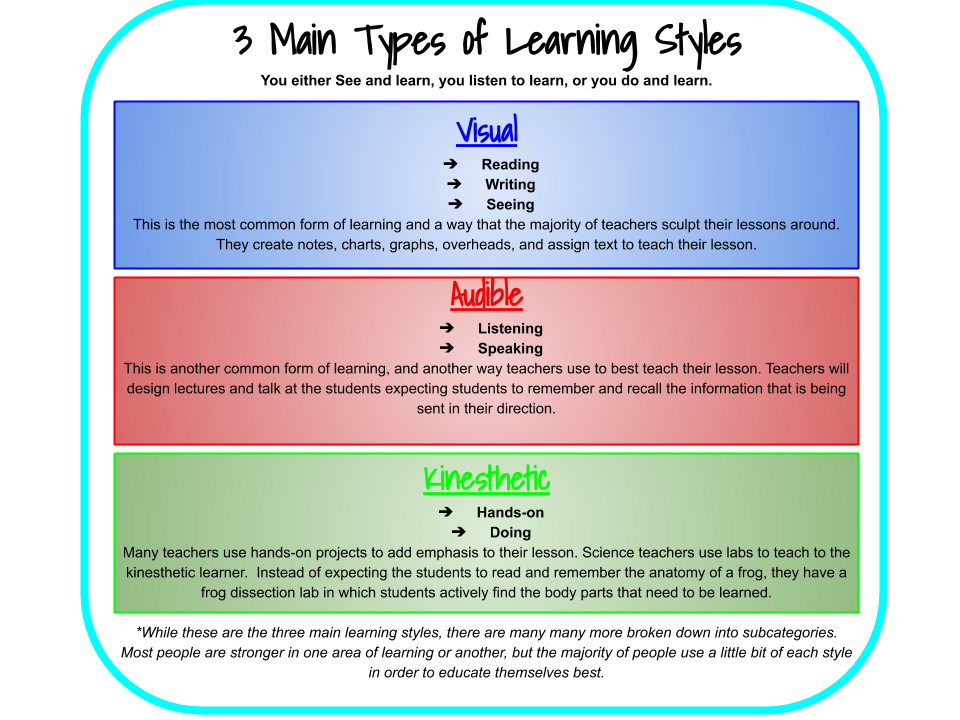
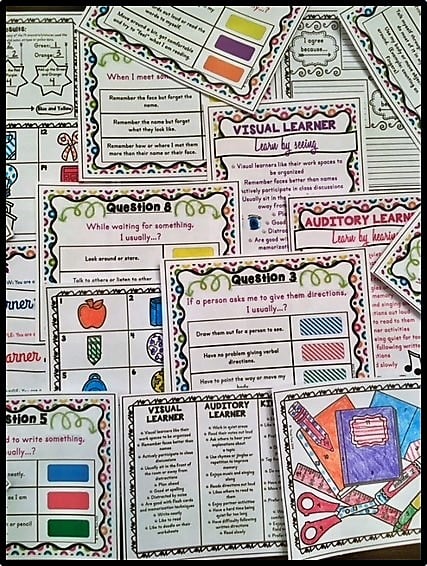
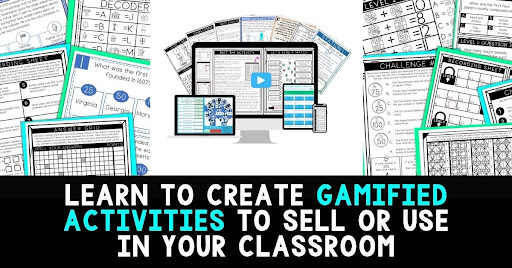
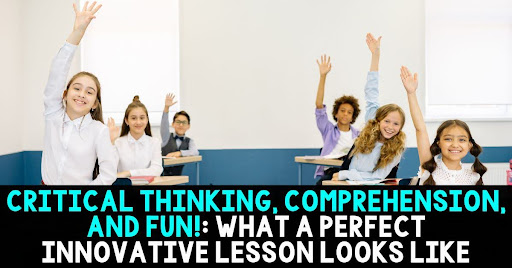
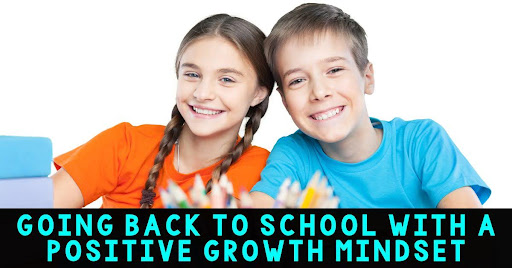

One Comment
Awesome blog. Love how it relates learning styles into real-life scenarios!